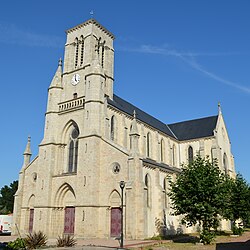Belleville-sur-Vie
Belleville-sur-Vie | |
|---|---|
 The church of Belleville-sur-Vie | |
| Country | France |
| Region | Pays de la Loire |
| Department | Vendée |
| Arrondissement | La Roche-sur-Yon |
| Canton | Aizenay |
| Intercommunality | Vie et Boulogne |
| Government | |
| • Mayor (2008–2014) | Régis Plisson (PR) |
| Area 1 | 15.16 km2 (5.85 sq mi) |
| Population (2006) | 3,595 |
| • Density | 240/km2 (610/sq mi) |
| Time zone | UTC+01:00 (CET) |
| • Summer (DST) | UTC+02:00 (CEST) |
| INSEE/Postal code | 85019 /85170 |
| Elevation | 55–84 m (180–276 ft) |
| 1 French Land Register data, which excludes lakes, ponds, glaciers > 1 km2 (0.386 sq mi or 247 acres) and river estuaries. | |
Belleville-sur-Vie is a former commune in the Vendée department in the Pays de la Loire region in western France. On 1 January 2016, it was merged into the new commune of Bellevigny.[1]
Geography
Belleville-sur-Vie is situated 15 km north of La Roche-sur-Yon and 40 km from Saint-Gilles-Croix-de-Vie on the Atlantic coast. The commune has an area of 1516 ha. 17 ha comprise 4 parks and 32 ha of green spaces. The main water source is the river Vie, a 62 km long stream which empties into the Atlantic at Saint-Gilles-Croix-de-Vie. The river has four tributaries, the Jaunay, the Petite Boulogne, the Gué Gorand and the Ligneron.
In twenty years the region has doubled in population to the total of 3,838 (INSEE 01/01/2009). 58% of the population is 40 years old and younger and 36% less than 25 years old.
100 commercial enterprises employ around 1400 people in the area.
Belleville-sur-Vie belongs to the group of 'communes' of Boulogne which also includes: Aizenay, Beaufou, La Génétouze, Le Poiré-sur-Vie, Les Lucs-sur-Boulogne, St. Denis la Chevasse et Saligny. It also belongs equally to the region 'Yon et Vie' which is a part of 23 communities belonging to the region 'La Roche-sur-Yon'.
Environment
Belleville-sur-Vie won two flowers at the cities and villages flowers competition (palmarès 2009). The first flower was awarded in 2007. The second flower was then awarded in 2009.
History
The fortified château of the seigneur (lord) of Belleville was constructed towards the end of the 11th century and included moat. From 935 AD, historians discuss a seigneur of Bellville, the familial line of the seigneur of Belleville ended in 1306 with the death of the last male heir, Maurice de Belleville. The sole and final heir Jeanne de Belleville outlived her spouse who was decapitated on order of the king of France for the crime of treason - his lands therefore summarily confiscated. After she remarried into the Harpedanne family (of English origins) she re-established herself in Poitou until the occupation following the treaty of Brittany (1360)
The family Harpedanne of Belleville received King Charles VI, and the new seigneur of Belleville took the name at the start of the 15th century. In the second half of the 17th century the seigneur of Belleville was made a baron. Around 1850 the Baron constructed a Town Hall with the stones of the ancient former stately home of the seigneur.
The ancient church was constructed at the end of the 17th century, and belongs to one of the most interesting eras of the Vendean Romanesque style of architecture ('epoque du roman vendéen' in French). In a ruinous state, all that remains is the portal composed of four concentric arches.
During the year 1793, Belleville made a plaque for the vendéan army. General Charette established a headquarters here during the terror (1794–95) and his efforts during the war forced the 'blues' to sign the Treaty of Jaunaye.
See also
References
- ^ Arrêté préfectoral 19 November 2015


